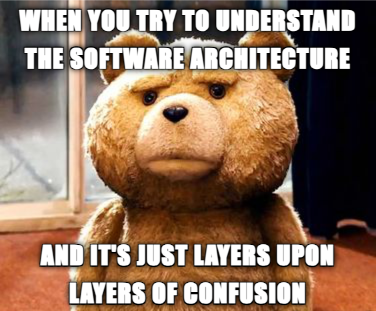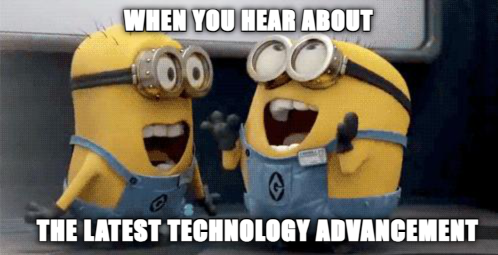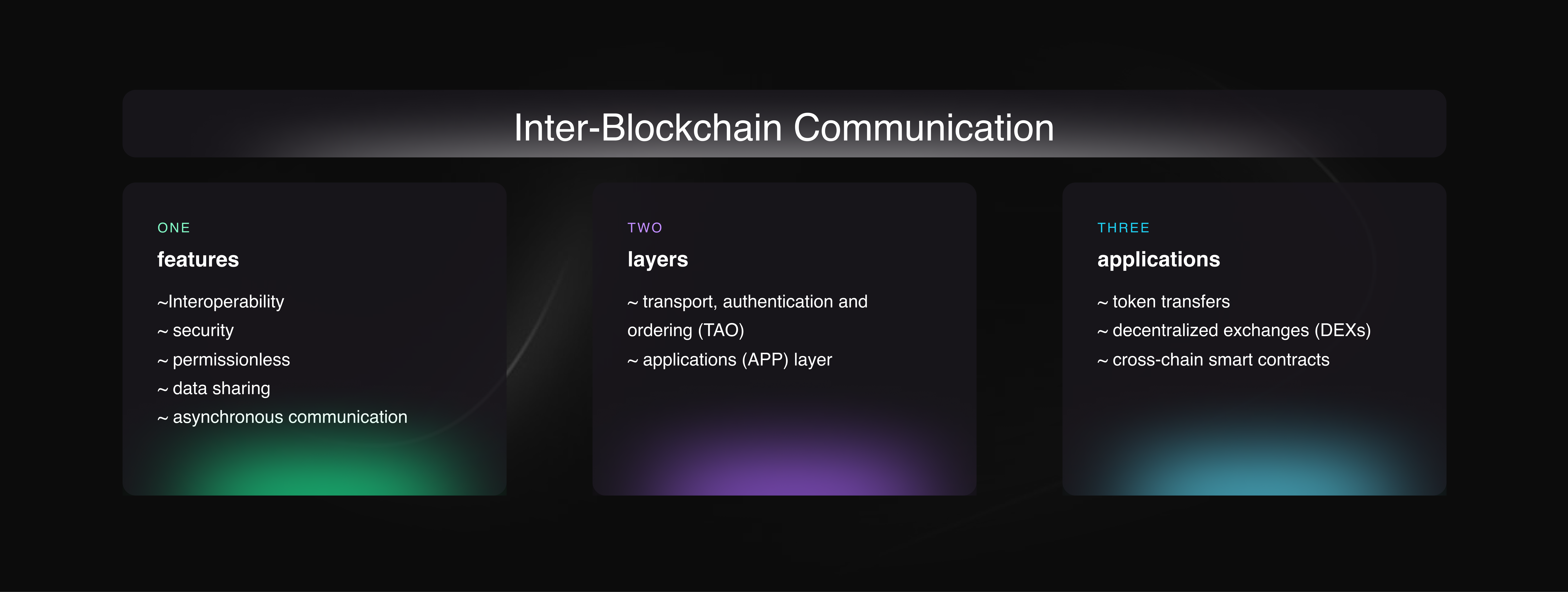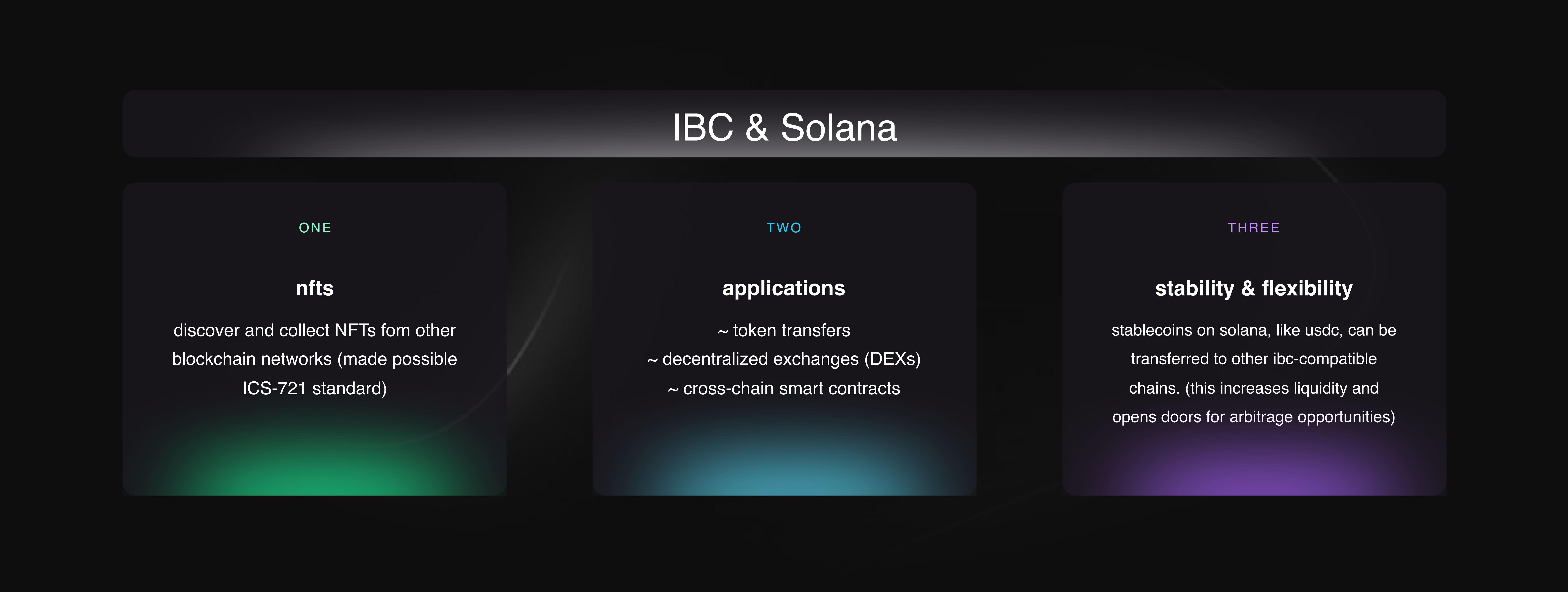The Inter-Blockchain Communication (IBC) Protocol and Solana
 Rudraksh Singhal
Rudraksh Singhal
Imagine a world where different blockchains, like separate islands, can talk to each other and share information and resources. This is the vision of the Inter-Blockchain Communication (IBC) Protocol, a game-changer in the blockchain space.
What is Inter-Blockchain Communication?
The Inter-Blockchain Communication (IBC) Protocol is a critical innovation in the blockchain space, designed to enable interoperability and communication between distinct blockchain networks. It allows for the secure and permissionless exchange of data and assets across different chains, which is essential for creating a more interconnected and efficient decentralized digital economy.
Think of it this way:
Blockchains are like isolated islands, each with its own information and resources. IBC helps these "islands" talk to each other, allowing them to safely share data and assets. This makes the whole blockchain world more connected and efficient, like building bridges between the islands. That's basically what an IBC does, in a nutshell.
That's all good, but what makes an IBC special? Let us see.
Features of IBC
First, let us talk about its interoperability. Basically, there are no more walled gardens! 🌷
What this means is that IBC allows blockchains, regardless of their underlying technology, to talk and exchange data like never before. This opens doors for cross-chain transactions, decentralized applications, and a unified ecosystem.
Second, its security. 🛡️
IBC eliminates the need for a central authority or any trusted third party by employing light client technology. This ensures secure communication without compromising on decentralization.
Third, the protocol is permissionless. 📜➜🚫
The protocol is open-source and permissionless, meaning anyone can build with IBC without concerns about in-protocol rent extraction or hidden fees.
Fourth, data sharing. 🗃️
IBC isn't limited to financial assets like tokens. It allows any type of data to be exchanged, paving the way for innovative applications like cross-chain identity verification and data sharing.
Fifth, asynchronous communication. 📣
IBC caters to diverse needs with flexible message delivery and confirmation, making it suitable for various workflows and applications.
Those were some of the main features of the protocol that make it special.

Let us now have a look at some of the key components of IBC.
Components of IBC
Clients: IBC clients are on-chain light clients that track the consensus states of other blockchains and the proof spec necessary to verify proofs from these blockchains.
In other words, they act as attentive guards, constantly monitoring activity on other IBC-connected blockchains.
Connections and Channels: IBC uses a model of connections and channels for communication, where a connection is a pair of light clients on two different blockchains, and a channel is a pipeline through which packets are sent between two modules on different chains.
Packets: The protocol enables the transfer of packet transactions, which are units of data containing information about the sender, recipient, and the data or assets being transferred.
Think of these as capsules carrying information. They contain details about the sender, receiver, and the data being transferred, ensuring secure and efficient communication.
So, where can IBC be used? Let us see some applications.
Applications of IBC
Token Transfers: IBC enables the transfer of fungible tokens and NFTs across chains, facilitating asset exchange between different blockchain networks.
Decentralized Exchanges (DEXs): It supports the creation of DEXs and open marketplaces, allowing for direct peer-to-peer transactions without intermediaries and reducing fees.
Cross-Chain Smart Contracts: IBC allows for the execution of smart contracts across different blockchains, enabling complex decentralized applications that operate across multiple networks. Basically, it allows for smart contracts with no borders.
Awesome! So we now know what an IBC is, what its features are, some of its components, and where and how it can be used.
But we have only scratched the surface! Let us dig in a bit deeper.
Layers of the IBC Protocol
The IBC protocol is structured into different layers, each serving a specific function in enabling interoperability between blockchain networks. The key layers of the IBC protocol are:
Transport, Authentication, and Ordering (TAO) Layer:
Client Layer: The initial state and lowest layer of the IBC protocol responsible for storing metadata about peer networks.
In other words, this acts as the base, storing information about other connected blockchains. Think of it as the initial handshake and introduction between chains.
Connection Layer: Acts as a transitional state between the client and application layers, facilitating the creation and management of connections between different blockchains. Imagine it as setting up a secure communication channel between two parties.
Channel Layer: This represents a conduit for data transfer between modules or applications on source and destination chains, allowing for the exchange of data packets. Think of it as a secure tunnel facilitating the flow of data between applications.
Relayer Component: This plays a crucial role in IBC by relaying messages between blockchains. This ensures secure and efficient communication without direct interaction between chains.
Application (APP) Layer:
Fungible Token Transfer (ICS-20): A protocol within the application layer that enables cross-chain token transfers (both fungible and non-fungible).
Interchain Accounts: Allows users to control accounts on other chains, enhancing interoperability.
Interchain Queries: This enables querying data across chains, providing flexibility in accessing information from different blockchain networks.
Non-Fungible Token Transfer (ICS-721): Facilitates the transfer of NFTs between interconnected blockchains.

Functionality of Each Layer
The TAO layer focuses on the transport, authentication, and ordering of data packets, ensuring secure and reliable communication between blockchains.
The Application layer builds on top of the TAO layer. It specifies how data packets should be interpreted, allowing for various cross-chain functionalities like token transfers and account management.
Relayers play a critical role in IBC by facilitating the relay of messages between blockchains, ensuring that data packets are securely transmitted and authenticated without direct chain-to-chain interaction.
Benefits of Layered Design
The layered design of the IBC protocol mirrors traditional networking protocols like TCP/IP, providing a structured approach to cross-chain communication.
Separating the TAO and Application layers allows for flexibility in designing new application-specific features while maintaining a standardized transport layer for seamless communication between blockchains.
The layered architecture of the IBC protocol ensures efficient communication, secure data transfer, and interoperability between diverse blockchain networks, laying the foundation for a more interconnected and scalable decentralized ecosystem.
IBC Standards
The Inter-Blockchain Communication (IBC) protocol relies on a set of well-defined standards to ensure secure and efficient communication between different blockchains. The development and documentation of IBC are maintained in a canonical repository on GitHub, where the Interchain Standards (ICS) are outlined.
Let's delve into the details of these standards and how they contribute to the overall functionality of the IBC protocol (you can click on the respective standards to learn more about them).
Core Transport, Authentication, and Ordering (IBC/TAO)
ICS 2: Client Semantics - Defines how clients (light clients) are verified and managed on blockchains.
ICS 3: Connection Semantics - Specifies the establishment and lifecycle management of connections between blockchains.
ICS 4: Channel & Packet Semantics - Describes how data packets are sent and received between blockchains.
ICS 5: Port Allocation - Details the allocation and use of ports for IBC channels.
ICS 23: Vector Commitments - Outlines vector commitments in IBC.
ICS 24: Host Requirements - Specifies requirements for blockchains to host IBC.
ICS 25: Handler Interface - Defines the interface for IBC handlers that process packets.
ICS 26: Routing Module - Describes the routing module responsible for routing packets between IBC ports.
ICS 33: Multi-hop Messaging - Details the sending IBC packets over multiple hops.
Light Clients
ICS 6: Solo Machine Client - Describes a type of light client for solo machines.
ICS 7: Tendermint Client - Specifies the light client for Tendermint-based blockchains.
ICS 8: Wasm Client - A draft standard for a WebAssembly-based light client.
ICS 9: Loopback Client - A draft standard for a loopback client that allows a blockchain to interface with itself.
ICS 10: GRANDPA Client - A draft standard for a light client for blockchains using the GRANDPA finality gadget.
Relayer
- ICS 18: Relayer Algorithms - Finalized standard for algorithms relayers use to facilitate IBC packet relay between chains.
Application Layer (IBC/APP)
ICS 20: Fungible Token Transfer - Describes the transfer of fungible tokens between chains.
ICS 27: Interchain Accounts - Allows users to control accounts on other chains.
ICS 28: Cross-Chain Validation - Details the process for cross-chain validation.
ICS 29: General Relayer Incentivization Mechanism - A candidate standard for incentivizing relayers.
ICS 30: IBC Application Middleware - Placeholder for middleware applications.
ICS 31: Cross-Chain Queries - A draft standard for querying data across chains.
ICS 100: Interchain Atomic Swap - Details atomic swaps between chains.
ICS 721: Non-Fungible Token Transfer - Describes the transfer of NFTs between chains.
These standards are categorized into Meta, Core Transport, Light Clients, Relayer, and App layers, each addressing different aspects of the IBC protocol. The stages of these standards range from Draft to Candidate to Finalized, indicating their level of maturity and readiness for implementation.
IBC Integration with Solana
The Inter-Blockchain Communication (IBC) protocol unlocks exciting possibilities for Solana users, expanding their access to valuable assets and applications in other blockchain ecosystems. Let us see how.
- Exploring NFTs:
IBC opens doors to a wider world of NFTs, allowing users to discover and collect NFTs from other blockchain networks. Imagine accessing unique collectibles and art beyond the Solana ecosystem, creating a richer and more diverse experience. This is made possible by the ICS-721 standard in the IBC application layer, which facilitates seamless NFT transfers across connected blockchains.
- Unlocking a Spectrum of Tokens:
IBC empowers Solana users to interact with tokens from other blockchains, including stablecoins, governance tokens, and utility tokens. This opens up a wealth of options, ranging from established tokens like ATOM on the Cosmos Hub to innovative tokens from various interconnected networks. Imagine seamlessly using and managing these tokens within your Solana environment.
- Stability and Flexibility:
With IBC, stablecoins on Solana, like USDC, can be transferred to other IBC-compatible chains. This increases liquidity and opens doors for arbitrage opportunities, benefiting traders and DeFi enthusiasts. Users gain greater flexibility in utilizing stable assets for various purposes, such as participating in yield farming across different ecosystems.
In essence, IBC acts as a bridge, allowing Solana users to venture beyond the confines of their own blockchain and explore the vast landscape of assets and applications available in other connected ecosystems.
Potential DeFi Use Cases Enabled by IBC Integration
The integration of IBC with Solana heralds a new era of DeFi innovation. Through cross-chain liquidity provision, DEX trading, yield farming, and cross-chain borrowing and lending, users can access a diverse array of financial services seamlessly across different blockchains. This integration paves the way for a more interconnected and efficient decentralized finance ecosystem. Let us talk about them.
Cross-Chain Liquidity Pools: Solana users could participate in liquidity provision across multiple blockchains, earning rewards from providing liquidity to various DeFi platforms. This could lead to the creation of cross-chain liquidity pools that span multiple blockchains, allowing for more diverse and resilient liquidity sources.
Interoperable DEX Trading: IBC would allow for cross-chain decentralized exchange (DEX) trading on Solana, enabling users to access a broader range of assets and trading pairs from interconnected blockchains. This could lead to more competitive pricing and a wider array of trading options for Solana users.
Yield Farming and Staking Opportunities From Other Chains: Through IBC, Solana users could engage in yield farming and staking activities with assets from other chains, potentially increasing their returns and diversifying their portfolios. This could include participating in staking on other IBC-enabled blockchains or engaging in yield farming strategies that span multiple ecosystems.
Cross-Chain Borrowing and Lending: The integration of IBC with Solana could facilitate borrowing and lending services across different blockchains, enabling users to leverage assets from one chain as collateral on another for various financial activities. This could unlock new financial products and increase capital efficiency within the DeFi space.

The integration of IBC with Solana holds significant promise for expanding the capabilities of the Solana ecosystem and providing users with access to a broader range of assets and DeFi opportunities. By leveraging IBC, Solana users can interact with assets from diverse blockchain networks, participate in cross-chain DeFi activities, and benefit from increased interoperability within the decentralized finance space. As the implementation of IBC progresses on Solana, it is expected to unlock new possibilities for innovation and collaboration across different blockchain ecosystems.

(Created Using Figma)

(Created Using Figma)

(Created Using Figma)
CONCLUSION
The Inter-Blockchain Communication (IBC) protocol presents a groundbreaking development in the blockchain landscape. By enabling seamless communication and data exchange between different blockchains, IBC fosters an interconnected and interoperable ecosystem. This unlocks exciting possibilities for users, as exemplified by the case of Solana integration. With IBC, Solana users gain access to a wider universe of NFTs and tokens, enhanced DeFi opportunities, and increased flexibility in managing their digital assets. As IBC continues to evolve and gain wider adoption, it has the potential to revolutionize the way we interact with and utilize blockchain technology, paving the way for a more unified and prosperous decentralized future.
REFERENCES
https://tutorials.cosmos.network/academy/3-ibc/1-what-is-ibc.html
https://tutorials.cosmos.network/academy/1-what-is-cosmos/3-interchain-use-cases.html
https://www.coinbase.com/cloud/discover/dev-foundations/ibc-protocol
https://ignite.com/blog/why-is-ibc-essential-for-blockchain-developers
https://www.linkedin.com/pulse/what-ibc-inter-blockchain-communication-lisa-jy-tan
https://coinmarketcap.com/academy/glossary/inter-blockchain-communication-ibc
https://www.linkedin.com/pulse/what-inter-blockchain-communication-protocol-ibc-gravityxcapital
https://www.industria.tech/blog/what-are-the-most-common-enterprise-blockchain-challenges-and/
https://glair.ai/post/challenges-in-the-adoption-of-blockchain-and-how-to-solve-them
https://coin98.net/what-is-inter-blockchain-communication-ibc
https://coinweb.com/wiki/inter-blockchain-communication-ibc/
https://treasuryxl.com/blog/blockchain-interoperability-solutions-and-challenges-where-are-we-now/
https://www.block360.io/blog/ibc-vs-cross-chain-bridge-which-one-you-need
http://troubles.md/comparison-of-inter-blockchain-communication-technologies/
Subscribe to my newsletter
Read articles from Rudraksh Singhal directly inside your inbox. Subscribe to the newsletter, and don't miss out.
Written by
